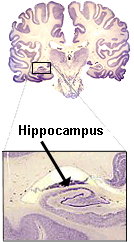 |
Changing
Dogma:
New Tricks for the Old Brain (Neurogenesis in Adult Humans) |
 |

|
By Ellen Kuwana Neuroscience for Kids Staff Writer  November 19, 1998
November 19, 1998You break your leg, you get a cast and the bone heals. You cut your skin, you bandage it and the skin heals. Even with serious bodily injury, like a severe burn or heart failure, skin grafts (new skin from a donor is attached to the burned area) or a heart transplant can repair the damaged area. But if you injure or kill your brain cells, there is nothing you can do--the damage is done. There are no brain transplants. The injury is permanent.
|
 | The dogma (a set of beliefs or ideas that is commonly
accepted to be true) that nerve cells in the adult brain, once damaged or
dead, do not replace themselves is being challenged. Research
indicates that at least one part of the brain in adults
maintains its ability to make nerve cells. Scientists in the United States and Sweden worked together on research that focused on a part of the brain called the hippocampus. (The word hippocampus comes from the Greek words, "Hippo" for "horse" and "kampos" for "sea monster" in Greek because of the shape of this area in the brain.) The hippocampus had already been shown in adult rodents (rats, mice and guinea pigs), monkeys, and birds to be able to produce new nerve cells. |  |
 | The hippocampus is part of the limbic system, which is also known as the "emotional brain" because it controls most of the involuntary aspects of emotional behavior related to survival: feelings of pleasure and pain such as anger, fear, and affection. The hippocampus is also involved in the processes of learning and memory. |
|
The scientists knew that physicians were injecting throat cancer patients
with the chemical bromodeoxyuridine (BrdU) for diagnostic purposes. When
cells divide and make new cells, BrdU is incorporated into the new cells.
Because cancer cells divide very rapidly, much faster than normal cells in
the body, cells that have BrdU in them will be new cells--old cells will
not have any BrdU in them. So, any new cells (which in this case would be the rapidly dividing and spreading cancer cells) would be "labeled" with the BrdU. Under a special kind of microscope, the cells with BrdU will look green and all other cells will look red. This color difference is how the scientists were going to tell normal cells from cancer cells--and gain information about how far the cancer cells had spread in the body, how well the treatment to kill the cancer cells was working, and the overall state of the cancer in the patient. After the patients had died battling the cancer, the scientists took a look at the brain tissue. If there were any BrdU-labeled cells, this would mean that those cells were new. If the adult hippocampus could not make any new nerve cells, the tissue would look red. Surprise, there were green cells in the hippocampus! |  |

| Question: But wait--how do the
scientists know that these cells in
the brain are not cancer cells like the green cells seen in the throat
(remember, the patients had throat cancer, so there were cancer cells in
that area that would be green). And now there are green cells in the
brain. Good question!! The scientists also did other tests on the cells in the brain to make sure they were not cancer cells and were indeed normal looking nerve cells. Why is this information so important? In general, as cells get more specialized, they are less able to divide and provide new cells. At first, there are general cells called stem cells. These cells are not trained for any certain job, so they can become any type of cell. After they start becoming a stomach cell, or a heart cell, they are more specialized, or suited for a particular job. This process is called differentiation. |
 Nerve cells, or neurons,
are some of the most specialized cells in the entire body. That is why
many researchers thought it would be unlikely for these very
differentiated cells to be able to produce new neurons. One scientist
proposed that human brains could not make new neurons because it would
interfere with our "higher functions" such as learning and memory. Nerve cells, or neurons,
are some of the most specialized cells in the entire body. That is why
many researchers thought it would be unlikely for these very
differentiated cells to be able to produce new neurons. One scientist
proposed that human brains could not make new neurons because it would
interfere with our "higher functions" such as learning and memory.
|
 | So don't throw away
your bicycle helmets yet--you still need to protect
your brain! There are still no brain transplants or magic cures if you hurt your brain. |
For more information on this
exciting discovery, see:
|

| BACK TO: | Neuroscience In The News | Table of Contents |
![[email]](./gif/menue.gif) Send E-mail |
 Get Newsletter |
 Search Pages |
 As exciting as showing
for the first time that a part of the brain can make new cells, this does
not mean that all of the brain can grow new cells. And although we now
know that neurons in the hippocampus can regenerate, we don't know yet if
these cells are functional--what if they look like the others but are in
fact not working? More research is needed, but this information may
someday help researchers develop treatments for diseases that attack the
brain, including Alzheimer's disease and Parkinson's diseases.
As exciting as showing
for the first time that a part of the brain can make new cells, this does
not mean that all of the brain can grow new cells. And although we now
know that neurons in the hippocampus can regenerate, we don't know yet if
these cells are functional--what if they look like the others but are in
fact not working? More research is needed, but this information may
someday help researchers develop treatments for diseases that attack the
brain, including Alzheimer's disease and Parkinson's diseases.